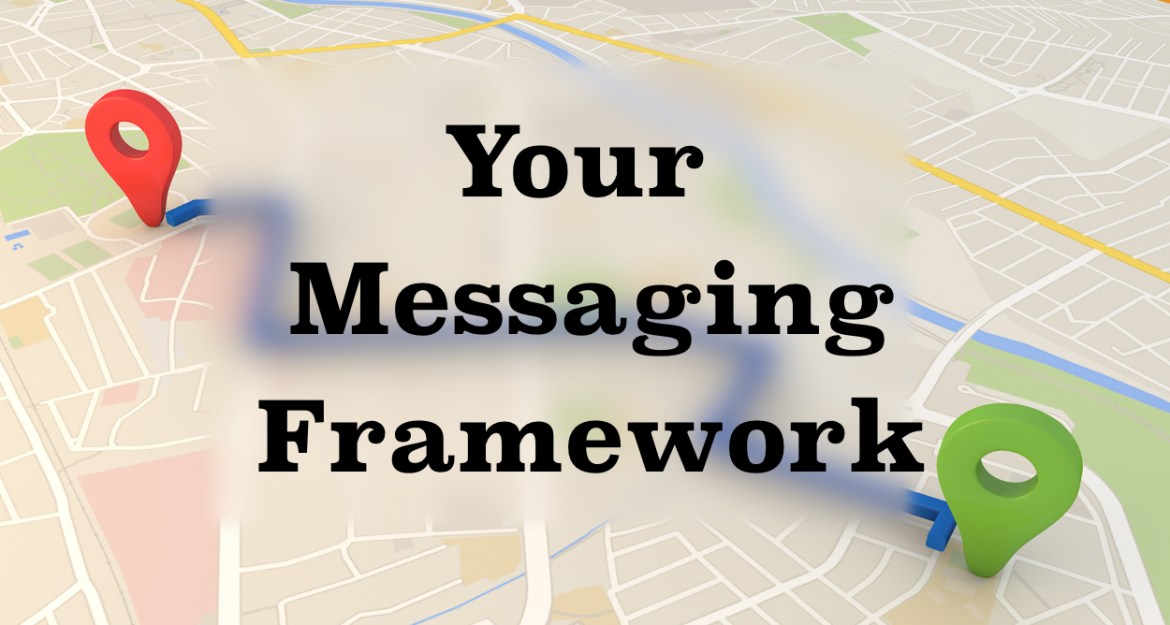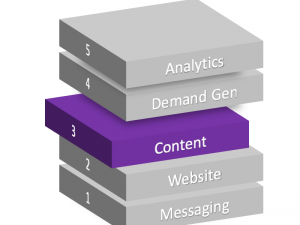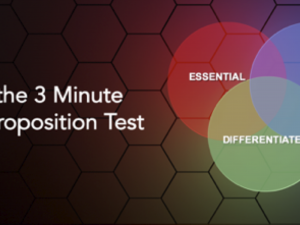
Marketing is Messaging
Quite simply, the essence of effective marketing is the value of your messaging. It’s the style and substance of how you communicate with your target buyers. Everything you do in marketing is simply a vehicle for packaging and delivering tailored messages to targeted buyers. Your messaging strategy is critical to your success. If you don’t get it right, all of your valuable marketing investments will be compromised, if not totally wasted.
Developing an effective messaging strategy doesn’t have to be complicated. Below I’ve outlined the essential steps for building an effective messaging framework for your business. I’ve also included a series of one-page templates that break down the mysterious challenge of messaging. And, simplify a highly strategic process that any business leader can perform.
Developing a winning messaging strategy revolves around 3 questions:
- Who are your ideal customers?
- Why do they buy from you?
- How do you beat the competition?
These questions force alignment between your audience and your messaging. They define an approach for building a messaging strategy that’s grounded in the market segments you serve. However, before you can define your messaging, you must understand what makes your target buyers tick. And before you define your buyer persona, you must understand the target segment, where they can be found, and your position in that market landscape.
Developing a marketing strategy can be difficult for business leaders. There are many variables to consider, angles from which to approach it, and ways to get off track. That’s why a roadmap has value. It provides a path to follow and a framework for developing a marketing strategy that is understandable for executives and actionable for the marketers they hire to execute it.
Who Are Your Ideal Customers?
Effective messaging is never a “one size fits all” proposition. Messaging must be tuned and tailored to reach and resonate well-defined buyers in well-defined markets. That raises the question of which segments to target. Most companies have several target segments. They can be horizontal or vertical segments in commercial markets or demographic segments in consumer markets.
Before you develop your messaging, select your primary target market and define the customer sets within that market. The image below shows a template for selecting a primary target market. It’s based on a rating system that scores 10 key factors for ranking each segment. The segments with the highest scores should be your primary segments. Lower scores indicate secondary targets or early-stage markets you plan to explore for future growth.

The imaginary scores in this example will illustrate the thought process. By asking and answering key questions, you will identify the markets that offer the greatest potential value and probability for success. Following is a condensed list of the questions in the table above:
- Where do you have the most domain experience and referenceable customers?
- What is the average deal value, volume, sales cycle, win ratio, and deal profitability?
- How strong is your competitive position in this market segment?
- Is there a strong level of demand now and is it expected to continue?
Rank each market segment to see where you are stronger and better positioned for success. When complete, you will see a heat chart to visually compare your market position across multiple segments and where you should focus your marketing investment to maximize growth.
Target Markets
After selecting your target market, the next step is to perform a one-page target market analysis to profile the target segment and customer sets you plan to pursue.
Analyze your target markets to:
- Document your strategy
- Align your people
- Focus your efforts
- Set performance targets
- Track your progress
The template below is a one-page target market analysis that will guide you through the process. The “Market Profile” section on the left is used to capture important elements of your go-to-market strategy for this segment. The “Customer Segments” section on the right is used to define specific customer segments within this target market.

Let’s look at the Market Profile section and answer the questions posed by each block.
- Market Landscape: Describe the companies in this segment, their products and services and the customers they serve. For consumer markets, describe the buyer demographics and the types of products or services they buy.
- Coverage Model: What geographies will you cover and what sales channels will be used to reach buyers in this segment?
- Business Potential: What is the overall size and growth rate of this segment?
- Industry Trends: What key industry trends affect the growth of this market? What are the biggest barriers to growth?
- Revenue Drivers: What factors trigger a purchase? Is revenue driven by price, value, innovation, risk, status, brand identity or something else?
- Competitive Environment: What are the major forms of competition in this market and who are your top 3 competitors?
Use the right side of the template to define the various customer sets for this segment. A customer set is used to profile different categories of buyers based on their business value, geographic location, type of business or a consumer demographic. Let’s look at some examples by starting with your “A list” customers. “A listers” might be your VIP accounts, high net worth clients or most lucrative consumers. Your “B list” might be customers that have a lower value than “A list” customers, but are more frequent or accessible buyers. Your “C list” might be customers that have the least value but offer the highest transaction volume.
The way you define your customer sets is up to you. Each customer set may require a slight variation of your messaging strategy. They should also allow you to set appropriate sales targets for the average deal value and expected deal volume. Map these values to your revenue goals and task marketing with the execution of effective strategies for achieving them.
Why Do Customers Buy From You?
Now that we have profiled our target market segment and set achievable revenue targets for success, we are ready to develop a messaging framework to engage with buyers in that segment. The template below is a one-page messaging framework I use to establish the building blocks of effective messaging. It also guides the development of your buyer persona, value proposition, and branding strategy. Collectively, these are the ingredients of your target marketing strategy. Let’s start by looking closely at the building blocks. Carefully consider the question in each one and be sure to answer them honestly and completely.

The Building Blocks of Effective Messaging
- The Audience: Describe your buyer. Is he or she the decision-maker? For B2B, what is this person’s role in the organization? For B2C, describe the buyer demographics.
- Pain Points: What are the most pressing problems or challenges the buyer must overcome? What keeps them up at night? Define a problem your buyer is trying to solve.
- Future Vision: Now describe your buyer’s aspirational goals. Ask and answer questions in the following format: What if you could ___? How would you benefit from ___? Imagine this outcome ___?
- Value Drivers: Explain how your product or service solves this problem and enables this future vision. What is it about your solution that uniquely meets the needs of the buyer?
- Benefits Realized: What is the ultimate value your buyer will realize after choosing your solution? These benefits can be economic, organizational or personal in nature.
- Proof Points: What customer examples or 3rd party endorsements provide evidence for your claims? Think of success stories, before & after comparisons, market research, etc.
The Buyer Persona
After completing the building blocks, it’s important to document the Buyer Persona. While it has some overlap with the building blocks, it also has a different purpose. It serves as a specification for targeting the type of buyers you are looking for and what they care about.
Titles & Responsibilities: What is the range of titles for this buyer? There may be multiple titles for your buyer. If you plan to search for them on LinkedIn, titles are one of the primary search filters you will use to find them. Describing their responsibilities should reveal keywords that your buyer would use in a LinkedIn profile – another important search filter. For B2C markets, be specific about the role and position of your buyer (e.g., professional, athlete, student, retiree, homemaker, etc.).
How Success is Measured: Describe the buyer’s goals and aspirations. This may be the same as, or related to, the “Future Vision” building block covered above. If so, expand on it. In business for example, how are they measured? What does success look like? For consumers, what constitutes a successful purchase and leads to ultimate buyer satisfaction?
Interest Areas: What are the buyer’s top concerns? This may be the same as, or related to, your answer to the “Pain Points” building block above. If so, expand on them. Be sure to catalogue the range of topics related to your solution that will interest them. Later, you will build these topics into your marketing campaigns and develop them over time with your content strategy.
Trigger Events: What events can trigger buyer interest and action? In business, this might be an organizational change or strategic initiative, like launching a product or cutting costs. For consumers, it could be something in need of an upgrade or replacement.
Influential Stakeholders: Who else plays a role in the purchase decision? Are there other parties who act as influencers, stakeholders, and budget allocators? If so, what decision factors are important for them? You may want to message to them directly or equip your decision-maker with informational content to address their concerns.
Information Sources: How does the buyer research potential solutions? Unless they are truly impulsive, all buyers go through a learning process. They may search google, visit educational websites, or read industry-specific magazines. What are the online and offline channels that should be leveraged to reach them?
How Do You Beat Your Competition?
Now that you understand the pain points, goals and aspirations of your target buyer. And, the ability of your solution to remove their pain and realize their vision, we have to go one step further. You will need to differentiate your solution from the competition by demonstrating how you are unique, different and better than competing solutions.
The first box in the template below asks for your “secret sauce”, a core advantage that you have over your competitors. This is a critical aspect of messaging. Without differentiation, your solution may offer value to your buyers, but if you’re no better than the competition, you will be positioned to either lose the sale or resort to discounts and price reductions. A competitive advantage increases your win probability and justifies your price. It’s well worth spending some time to identify your differentiation as ammunition to beat the competition. If you can’t identify a strong competitive advantage, then it’s a gap in your solution that you need to fill.

The second box asks the question, “Why are you a MUST-HAVE”? This question is important because one form of competition is when buyers fail to act. In the world of sales, this is called “losing to no decision”. When does this happen? When products and services are only a “NICE-TO-HAVE” instead of a “MUST-HAVE”. Into what category does your solution fall? Spend some time understanding what makes your solution essential and indispensable to your buyer.
The third box asks for your WOW FACTOR. There are a number of ways to inspire buyers. Perhaps your solution is based on a cool invention or product feature. Perhaps you have an edgy trend-setting style or product design. You can also inspire buyers with groundbreaking performance. Or, a compelling testimonial from a highly influential person or organization. Maybe you have an inspirational story about the founding of your company and its mission.
Any of these strategies for differentiation can be used to answer two litmus test questions important to any sales and marketing person. “Why will we win?” And the inverse question. “How can we lose?” Your marketing and sales teams should be in total alignment on all aspects of your messaging, but especially in regard to answering these questions.
Your Value Proposition
Now you have all the ingredients needed to formulate your value proposition. Think of this as your elevator pitch. A good way to create your value proposition is by forcing yourself to articulate your story in 50 or 100 words. I like to create both versions because you will find times when a very short 50-word company description is appropriate (e.g. a trade show flyer or program description). And, other times when you can use 100 words to more fully explain your value (e.g., a boilerplate paragraph at the end of a press release or the “About” page on your website). The 50-word description should be just 3 or 4 sentences. The 100-word description should be no more than 4 or 5 sentences.
Compose your value proposition (i.e., elevator pitch) in this format:
Who You Are: Something about your company and credentials.
What You Do: Something about the solutions you offer and customers you serve.
Why You Are Different: Something about why you are special and how you deliver value.
What is Your Brand Promise?
In this article, we have been building a messaging framework from the ground up. Starting with building blocks. Adding differentiated value. And, documenting a buyer persona and value proposition along the way. Now we have a great foundation to define your brand identity and brand promise. Another way of saying what you stand for and how the marketplace should think of you. The most successful brands have a memorable way to communicate the essence of their brand identity (e.g., BMW is the ultimate driving machine).
I will use my own branding strategy as an example. As Virtual CMO, my role is to work with business leaders to make marketing more accountable and productive in delivering a measurable ROI. My value is in demystifying the science of marketing so it can be applied to any business in a cost-effective and practical way. My brand promise is to develop successful strategies that simplify and solve complex marketing challenges. My tag line is the phrase “Simply Strategic Marketing”, three words that capture the essence of what I do.

Now it’s your turn. Use the template above to articulate your brand promise in a sentence or two. Then formulate a 3 to 5-word tag line that captures the essence of that brand promise. When you have completed all of the templates described in this article, you will have established a comprehensive and cohesive messaging framework that will serve as a solid foundation for everything you do in marketing.
To request a copy of the marketing templates so you can create your own messaging framework, just drop me a note at dave@vcmo.net.
In the next article of the Executive Marketing Roadmap series, I’ll describe how to use this framework to optimize your most important digital marketing asset, your website. Until then, if you would like to take a holistic look at your marketing function to understand your strengths and weaknesses, identify gaps and focus on ways to improve them, take this business-driven marketing assessment. It will help you to continuously improve your marketing efforts and treat them as investments for future growth.
TAKE THE BUSINESS-DRIVEN MARKETING ASSESSMENT


